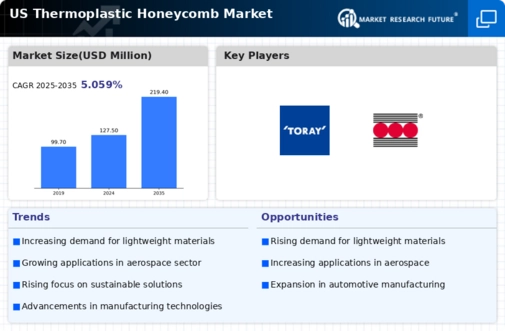The competitive landscape of the US Thermoplastic Honeycomb Market is characterized by a growing demand for lightweight, high-strength materials across various industries, including aerospace, automotive, and construction. This market has seen a significant influx of players, driven by technological advancements and innovations that enhance material performance and application versatility. Companies are focusing on developing advanced thermoplastic honeycomb structures to meet the evolving needs for improved fuel efficiency and sustainability. The competitive environment is shaped by several factors, including pricing strategies, product differentiation, and the ability to maintain strong supply chain networks.
As industry players vie for market share, collaborations, joint ventures, and strategic partnerships have become commonplace, highlighting the dynamic nature of this market.In the context of the US Thermoplastic Honeycomb Market, Solvay SA stands out due to its robust portfolio and a commitment to innovation. The company has established itself as a key player by offering a range of advanced thermoplastic honeycomb materials that cater specifically to the needs of aerospace and automotive industries. Solvay SA’s strengths lie in its extensive research and development capabilities, enabling the design of products that meet stringent performance standards and regulatory requirements.
The company’s strategic focus on sustainability has positioned it favorably in the market, allowing it to capitalize on the increasing demand for eco-friendly materials. With a strong market presence, Solvay SA has built lasting relationships with various stakeholders, ensuring a competitive edge in the provision of lightweight, durable honeycomb solutions.Mitsubishi Chemical Corporation is another significant entity in the US Thermoplastic Honeycomb Market, recognized for its innovative product offerings and strategic market presence. The company is known for its advanced thermoplastic composites, which are utilized in various sectors, including aerospace, automotive, and industrial applications.
Mitsubishi Chemical Corporation emphasizes research and development, leading to the creation of high-performance materials that meet specific customer needs. Its strengths are further enhanced by strategic mergers and acquisitions, allowing the company to expand its product range and enhance its market footprint. By leveraging its technological expertise, Mitsubishi Chemical Corporation consistently introduces cutting-edge solutions that align with evolving industry standards. The company's commitment to sustainability and customer-centric approach positions it favorably in the competitive landscape of the US Thermoplastic Honeycomb Market.













Leave a Comment